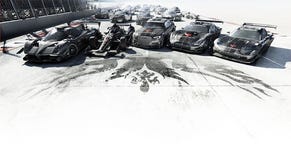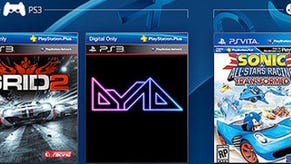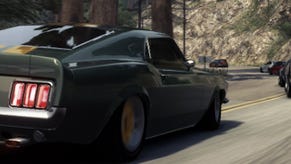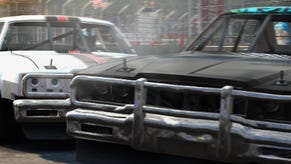GRID 2: bringing the race and a narrative together
Codemasters is going hard on story in its GRID sequel, as Phil Owen discovered when he saw the racer in LA. New screens and video included.
Thus far, Codemasters has kept GRID 2 pretty close to the vest, not really telling us anything about it other than that it exists and that it will totally be a good sequel to a revolutionary racing game and that it will contain a dynamic, course-altering function called LiveRoutes on the street races.
Earlier this month, though, I had the chance to sit down with some of the developers, including executive producer Clive Moody, and they spilled the beans just what exactly GRID 2 will do to hook players in its single-player modes.
What has been the overall objective in the biggest racers in the past few generations? To collect cars? To progress through racing series? To just race over and over and over again? In truth, most racing games don't really have a hook beyond the simple thrill of the races themselves. And maybe they didn't need anything more than that.
“A lot of [racing] games out there tend to lack a bit of soul. They can be quite a dry experience. We’re trying to pull this into something that’s a little bit more interesting [with] some sense of purpose.”
In 2011, EA tried something new with Need for Speed: On the Run, an arcade racer with an honest-to-God story. Codemasters wants to do something similar without making an experience that is perfectly linear. The company wants to provide real context for your racing activities.
"How do you find the best driver with all that diversity in the world of motor racing?" Moody asked. "That's a question that we think is pretty compelling and that we're really interested in trying to answer. If you take the world of sport in general you will see there are events that try to do this, try to answer those questions. Things like Mohammad Ali vs. Antonio Inoki – that pitted Japanese wrestling vs. boxing.
"Or similarly the 100-meter race with Donovan Bailey and Michael Johnson, when they raced to see who was the fastest man on Earth. So it's not without precedent, but there's nothing really like that within the world of motor racing.”
With GRID 2, Codemasters' objective became to create such an event, a World Series of Racing, in a digital world so that players can at least imagine what such a thing would be like. As such, it gives players a concrete objective to work for, just as you would play to win the Champions League in FIFA or the Super Bowl in Madden rather than the nebulous satisfaction of beating the computer and buying cars.
“A lot of [racing] games out there, they tend to lack a bit of soul, you know what I mean?” Moody continued. “They can be quite a dry experience, and so we're trying to pull this together into something that's a little bit more interesting, a little bit more compelling, and actually gets away from that grind of doing event after event or collecting cars. It gives some sense of purpose to it.”
They don't want GRID 2's campaign to feel like it takes place in a video game world, and presentation is a high priority to Codemasters.
“It's really important to us that we set this in a world that feels believable,” Moody commented. “We want to have the credibility of reality. As you see now, we've got a partnership with ESPN. We're really happy to have those guys on board, because they're the world leader in television sports presentation.”
Rome wasn't built in a day, however, and the development of this world championship will actually be a part of GRID 2's story, Moody explained.
“In order to make this happen in the real world, it needs a visionary," he said. "It needs an entrepreneur. It needs somebody who actually spots that gap in the market and can make it happen. That person in our game is a guy called Patrick Callahan.”
As part of the presentation, I was shown a video featuring this Callahan character -- who, I should point out, is fictional – and he expressed his vision for the future of the world of motorsports. It was a compelling speech; I definitely felt as if I was on board with his plan after listening to him talk about how he wants to bring together “the high-speed racers from the US, the technical guys from Europe and the drift kings of Asia all in one competition, to determine the world's greatest driver.”
I don't know about you, but I'm excited to be a part of this dream, and such an event seems likely to keep me playing the game far longer than I would most racers that don't have a true endgame objective.
“It’s really important to us that we set this in a world that feels believable. We want to have the credibility of reality.”
In GRID 2, you are a young up-and-coming racer, and Callahan wants you to “be the spark” that unites the racing community under this World Series banner. And so, Moody said, you're goal is to work your way up through the ranks of racers in North America, Europe and East Asia in order to show what a true master of the driving craft, which you will hopefully become, can do for the sport.
“Around the world there are numerous clubs, small racing clubs, all of whom drive in their own locations, drive in their own types of car, have their own types of race events, have their own rules around those race events, and actually look as well,” Moody told me. “And his dream is to unify all of those race clubs around the world.”
And the player is his instrument by which he can accomplish that, by racing with and against them and gaining their respect, essentially. If you become The Man, these guys will follow you. But it's a long road.
“From the outset of the game you start in the US, and just racing in the US,” Moody explained. “And you're racing at club level against these individual clubs and within these individual clubs, trying to gain fans, trying to raise popularity. Once within the US you've gained enough fans and you've got those drivers on board, then all those separate clubs form together to race within these World Series events on this regional basis.
“And it's a format that is then repeated within the game as you dot around the world. So season two you go across to Europe, again taking the same process.” Once you've conquered Europe, you move on to Asia.
As Moody described above, your fanbase will play an important role in your rise. “Your fanbase is actually your currency. It's the mechanic by which you progress through the experience. When you start out in the game, nobody knows who you are. You're the new guy. So you're going to go out there and compete, and the guys attending those races are going to see what you're doing and words starts starts spreading.
“This idea of wrapping narrative on it is a big step up, and a neat way of encapsulating the huge diversity that this game offers up."
“And word starts spreading through media, and this a way in which we help drive that narrative journey for the player and the narrative journey of this concept of this World Series as well. So from the outset in those early stages, what you get is guys who go to these events, they are emailing, they are text messaging, they are posting stuff up on social media sites.
"It steps out from just being that viral thing on social media. Print starts to get a hold of it. Papers, magazines will start writing features about your rise through this world and also the rise of the World Series. It ultimately gets to the point where big media organizations get interested and EPSN coming on board and signing up for the global TV rights.”
What is written above is more or less what you can expect from the structure of GRID 2's single-player component, and it will all sound oh so familiar to fans of sports games – which is in no way a bad thing, as the racing genre has long needed such a structure, and that it has a narrative is just a plus.
While all this sounds quite neat, I'm not convinced that GRID 2 will alter the racing genre the way its predecessor did in 2008 with the introduction of the mid-race rewind feature that has become a staple in subsequent racing games. Moody, on the other hand, insists that the combination of the single-player narrative and the LiveRoutes system, which alters the layout of a track from lap to lap, make GRID 2 yet another game-changer for Codemasters.
“This idea of wrapping this narrative on it, I think, is a big step up, and [is something] fans of racing games are really gonna love. It's gonna keep the experience fresh. It's gonna give them that real sense of purpose. It's a really clever and neat way of encapsulating the huge diversity that this game offers up.
“When you take those three base forms of motorsport and then within those... there's way over a dozen different race types we have within the game, and the various clubs will partake in some and not in others, so at every stage you're getting a fresh experience coming up.”
Codemasters is still holding back plenty of details about the game – I've been told they're mixing up the way Flashback works, for example – and we'll have to wait a couple more months to find out just what those details are. But seeing as how GRID 2 is the only new racing game currently on the schedule for 2013, we'll have to take what we can get.
GRID 2 will launch the last week of May on PC, PS3 and Xbox 360.










